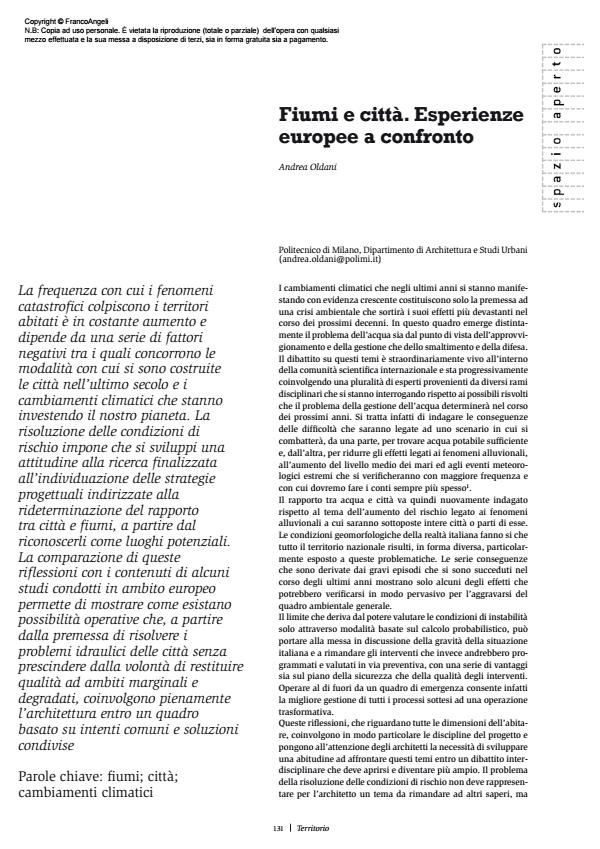Rivers and cities. A comparison of European experiences
Journal title TERRITORIO
Author/s Andrea Oldani
Publishing Year 2013 Issue 2013/64 Language Italian
Pages 7 P. 131-137 File size 563 KB
DOI 10.3280/TR2013-064022
DOI is like a bar code for intellectual property: to have more infomation
click here
Below, you can see the article first page
If you want to buy this article in PDF format, you can do it, following the instructions to buy download credits

FrancoAngeli is member of Publishers International Linking Association, Inc (PILA), a not-for-profit association which run the CrossRef service enabling links to and from online scholarly content.
The frequency with which disasters hit inhabited areas is increasing constantly and depends on a series of negative factors which include the ways in which towns and cities were built in the last century and the climatic changes that are affecting our planet. The resolution of risk conditions requires the development of an attitude to research designed to identify planning strategies which try to the redetermine relationships between cities and rivers, starting by recognising them as places with potential. Comparison of this thinking with the contents of studies conducted in Europe shows that working possibilities exist which, starting with the requirement to solve the waterway problems of cities without ignoring the desire to raise the quality of marginal and rundown areas, fully involve the architecture within a framework based on common intentions and shared solutions.
Keywords: Rivers; cities, climate change
- Freie und Hansestadt Hamburg – Behörde für Stadtentwicklung und Umwelt – Amt für Bau und Betrieb Abteilung Hochwasserschutz,
- 2006, Information about Flood Protection in the HafenCity Hamburg, Hamburg.
- Garin E., 1985, Scienza e vita civile nel Rinascimento italiano, Laterza, Bari.
- Gregotti V., 1966, Il territorio dell’architettura, Feltrinelli, Milano.
- Hamburg Agency of Roads, Bridges and Waters, 2011, Flood Protection for Hamburg’s Niederhafen Port. Construction of the New Niederhafen Flood Protection Barrier in Hamburg City Centre, Hamburg.
- Hooimeijer F., Toorn V.W., 2007, More Urban Water: Design and Management of Dutch Water Cities, Taylor & Francis Group, London.
- Martì Aris C., 2007, La cèntina e l’arco: pensiero, teoria, progetto in architettura, Christina Marinotti edizioni, Milano, p. 54.
- Mitchell J.F.B., Lowe J., Wood R.A., Vellinga M., 2006, «Extreme Events Due to Human-Induced Climate Change» Philosophical Transactions: Mathematical, Physical and Engineering Sciences, vol. 364, n. 1845, «Extreme Natural Hazards».
- Oldani A., 2011, From Space to Place: Architectural Design Strategies for River Banks, in «Acqua Alta; Exhibition and International Conference on Climate Impact, Flood Protection and Hydraulic Engineering, Conference Publication», TuTech Verlag, Hamburg, Germany.
- Valente I., 2002, «Lo spazio aperto: sfondo, figura, frammento dell’architettura delle connessioni», Territorio, n. 20, pp. 114-119. Veelen P., Boer F., Hoijink R., Schelfhout H., Haselen C., 2010, Veilige en goed ingepaste waterkeringen in Rotterdam (Safe and Integrated Levees in Rotterdam), Rotterdam.
- Veelen P., 2011, Local Adaptation as a Future Flood Management Strategy in Rotterdam?, in «Acqua Alta; Exhibition and International Conference on Climate Impact, Flood Protection and Hydraulic Engineering, Conference Publication», TuTech Verlag, Hamburg, Germany.
- Veelen P., Leeuwen J., 2011, Safe and Multifunctional Urban Levees in Rotterdam, in «Acqua Alta; Exhibition and International Conference on Climate Impact, Flood Protection and Hydraulic Engineering, Conference Publication», TuTech Verlag, Hamburg, Germany.
- Vonk L., 2006, Rotterdam: Living with Water, proceedings of the 42nd Isocarp Congress (http://www.isocarp.net).
Andrea Oldani, Fiumi e città. Esperienze europee a confronto in "TERRITORIO" 64/2013, pp 131-137, DOI: 10.3280/TR2013-064022